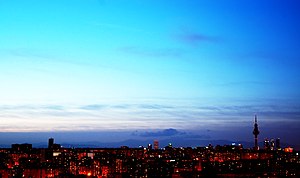La Movida Madrileña
This article may require cleanup to meet Wikipedia's quality standards. The specific problem is: Unreferenced, original research, copy edit, excessive red links. (September 2015) |

La Movida Madrileña (Template:Lang-en) was a countercultural movement that took place mainly in Madrid during the Spanish transition after Francisco Franco's death in 1975. The movement coincided with economic growth in Spain and the emergence of a new Spanish identity. The "Concierto homenaje a Canito" ("Canito Memorial Concert"), taking place on February 9th, 1980, is widely considered the traditional start date of La Movida Madrileña.
This hedonistic cultural wave was born in Madrid, then appeared in other Spanish cities, such as Barcelona, Bilbao and Vigo. It was characterized by freedom of expression, transgression of the taboos imposed by the Franco regime, use of recreational drugs, the "coming out" of the Madrilenian cheli and the "pasota" dialect and a new spirit of freedom on the streets.
Famous representatives
The Movida comprised many art movements; Pedro Almodóvar became the best known example internationally after his later success as a film director.
Music
In moods, looks and attitude, the sound resembled the British new wave and the Neue Deutsche Welle, sometimes mimicking styles such as new romantic.
Many bands from the capital city contributed to the spread of the movement, such as:
and many more. Synthpop pioneers such as Mecano, Azul y Negro, Tino Casal, La Unión and others are also sometimes considered to be part of this movement.
Occasionally bands from other Spanish cities are considered as having taken part of the “Movida”, such as Siniestro Total and Golpes Bajos from Vigo, and Loquillo and Desechables from Barcelona.
Contemporary Spanish rock bands, such as Leño, Barón Rojo, Obús, Asfalto or La Polla Records, are, on the contrary, usually not included under the “Movida” tag, as their sound was harder and they rejected what the movement represented.
Film and television
Film director Pedro Almodóvar comically reflected the messiness of the freedom of those years, especially in his first films, such as Pepi, Luci, Bom y otras chicas del montón (1980), Laberinto de pasiones (1982) and What have I done to deserve this?! (1984) . Other important artists in the Movida were the director Iván Zulueta with his masterpiece Arrebato, Fernando Trueba with the characteristic Ópera prima (1980) and Fernando Colomo.
TV programs like La Bola de Cristal, hosted by singer Alaska and La Edad de Oro, hosted by Paloma Chamorro contributed to spread the aesthetics of the movement to a wider audience.
Photography and painting
Graphic artists like Ceesepe, El Hortelano, Montxo Algora, Agust, Pejo and Nazario Luque, and photographers like Ouka Leele, Miguel Trillo, Pablo Pérez Mínguez “PPM” or Alberto García-Alix together founded one of the first art collectives, called “Cascorro Factory”, where many of the seminal ideas for the “Movida” took place. Also, photographer Gorka de Duo accompanied artist Andy Warhol and had an exhibition with Robert Mapplethorpe in the Fernando Vijande gallery.
Painters Patricia Gadea and husband Juan Ugalde formed later in New York City the art group Estrujenbank, and Costus (Enrique Naya Igueravide & Juan José Carrero Galofré) and Guillermo Pérez Villalta, from Cádiz, and Valencian Javier Mariscal were also essential visionaries for the movement.
Graffiti
Artists like Muelle created a unique form of street art, later described as “graffiti autóctono madrileño”.
Literature
Writers Gregorio Morales, Vicente Molina Foix, Luis Antonio de Villena, Javier Barquín, José Tono Martínez, Luis Mateo Díez, José Antonio Gabriel y Galán, José Luis Moreno-Ruiz and Ramón Mayrata were prominent in the “Tertulia de Creadores”, which were a cycle of meetings, lectures, debates and happenings that took place in the Círculo de Bellas Artes in Madrid between 1983 and 1984. Many of them, as Gregorio Morales, José Tono Martínez or Ramón Mayrata, were regular collaborators of the art magazine La luna de Madrid. Also, Oscar Mariné's magazine Madrid Me Mata (Madrid Kills Me) contributed to the creation of a common identity.
Another important figure outside the artistic world of the Movida was journalist Francisco Umbral, writer for the newspaper El País, who wrote about and documented the movement.
Comics
The magazine Madriz acted as a post-modern mixer for the new tendencies between 1984 and 1987. Artists like Antonio Aragüez, Arranz, Camús, Asun Balzola, Federico del Barrio, Juan Calonge, Guillem Cifré, El Cubri, Santiago Cueto, Kiko Feria, Carlos Giménez, Guzmán el Bueno, Juan Jiménez, Ana Juan, LPO, Marcos, Martín, Ana Miralles, Rafa Negrete, José Manuel Nuevo, OPS, Raúl, Rubén, Sento, Luis Serrano, Carlos Torrente, Fernando Vicente graced its pages.
The Barcelona-based magazine El Vibora, founded in 1979, was also influenced by the zeitgeist of the era, and published, apart from translations of foreign material, artists such as Nazario, Max and Miguel Gallardo.
Afterwards
Many films and books have depicted the Movida, like the 2005 film El Calentito directed by Chus Gutiérrez. Also, the musical Hoy No Me Puedo Levantar, composed by Nacho Cano, former member of Mecano, portrays a love story with the Movida as cultural background, and explains the condition of young people in this period, trying to survive in Madrid under the shadow of drugs and AIDS.

